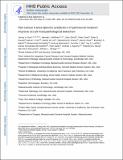Pan-cancer Transcriptomic Predictors of Perineural Invasion Improve Occult Histopathologic Detection
Author(s)
Guo, Jimmy A; Hoffman, Hannah I; Shroff, Stuti G; Chen, Peter; Hwang, Peter G; Kim, Daniel Y; Kim, Daniel W; Cheng, Stephanie W; Zhao, Daniel; Mahal, Brandon A; Alshalalfa, Mohammed; Niemierko, Andrzej; Wo, Jennifer Y; Loeffler, Jay S; Fernandez-del Castillo, Carlos; Jacks, Tyler; Aguirre, Andrew J; Hong, Theodore S; Mino-Kenudson, Mari; Hwang, William L; ... Show more Show less
DownloadAccepted version (1.592Mb)
Open Access Policy
Open Access Policy
Creative Commons Attribution-Noncommercial-Share Alike
Terms of use
Metadata
Show full item recordAbstract
<jats:title>Abstract</jats:title>
<jats:sec>
<jats:title>Purpose:</jats:title>
<jats:p>Perineural invasion (PNI) is associated with aggressive tumor behavior, recurrence, and metastasis, and can influence the administration of adjuvant treatment. However, standard histopathologic examination has limited sensitivity in detecting PNI and does not provide insights into its mechanistic underpinnings.</jats:p>
</jats:sec>
<jats:sec>
<jats:title>Experimental Design:</jats:title>
<jats:p>A multivariate Cox regression was performed to validate associations between PNI and survival in 2,029 patients across 12 cancer types. Differential expression and gene set enrichment analysis were used to learn PNI-associated programs. Machine learning models were applied to build a PNI gene expression classifier. A blinded re-review of hematoxylin and eosin (H&E) slides by a board-certified pathologist helped determine whether the classifier could improve occult histopathologic detection of PNI.</jats:p>
</jats:sec>
<jats:sec>
<jats:title>Results:</jats:title>
<jats:p>PNI associated with both poor overall survival [HR, 1.73; 95% confidence interval (CI), 1.27–2.36; P &lt; 0.001] and disease-free survival (HR, 1.79; 95% CI, 1.38–2.32; P &lt; 0.001). Neural-like, prosurvival, and invasive programs were enriched in PNI-positive tumors (Padj &lt; 0.001). Although PNI-associated features likely reflect in part the increased presence of nerves, many differentially expressed genes mapped specifically to malignant cells from single-cell atlases. A PNI gene expression classifier was derived using random forest and evaluated as a tool for occult histopathologic detection. On a blinded H&E re-review of sections initially described as PNI negative, more specimens were reannotated as PNI positive in the high classifier score cohort compared with the low-scoring cohort (P = 0.03, Fisher exact test).</jats:p>
</jats:sec>
<jats:sec>
<jats:title>Conclusions:</jats:title>
<jats:p>This study provides salient biological insights regarding PNI and demonstrates a role for gene expression classifiers to augment detection of histopathologic features.</jats:p>
</jats:sec>
Date issued
2021Department
Massachusetts Institute of Technology. Department of BiologyJournal
Clinical Cancer Research
Publisher
American Association for Cancer Research (AACR)
Citation
Guo, Jimmy A, Hoffman, Hannah I, Shroff, Stuti G, Chen, Peter, Hwang, Peter G et al. 2021. "Pan-cancer Transcriptomic Predictors of Perineural Invasion Improve Occult Histopathologic Detection." Clinical Cancer Research, 27 (10).
Version: Author's final manuscript